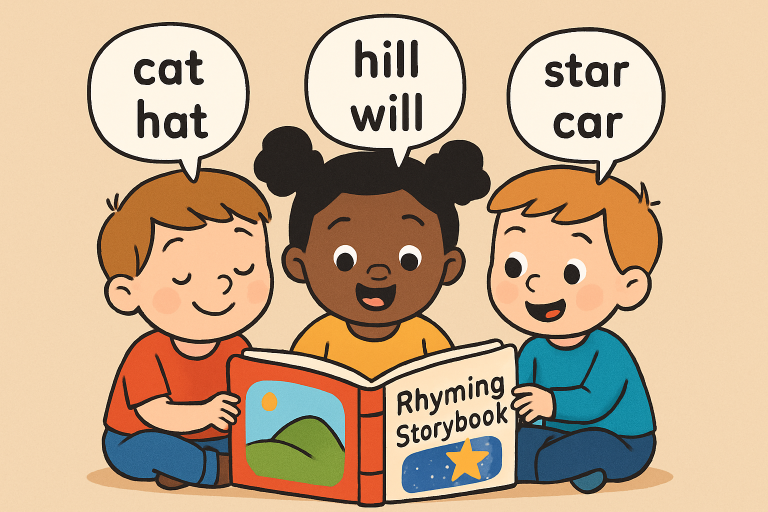The Role of Rhymes in Early Language Development
Rhyming is one of the earliest linguistic patterns young children encounter. These playful, repetitive sounds naturally attract a child’s attention and transform seemingly complex language concepts into fun, digestible experiences. Through nursery rhymes and song, children learn to anticipate sounds, expanding their interest and engagement with spoken and written words. Research has shown that early familiarity with rhymes is strongly linked to later reading proficiency, making rhymes an essential foundation of early literacy education. For parents exploring diverse strategies, children’s language learning books frequently harness rhyme and repetition to maximize language gains in young readers.
The engaging structure of rhymes also fosters social interaction, as children delight in reciting verses and responding to rhythmic cues. This collaborative element encourages active participation and deeper comprehension, qualities critical for both language acquisition and long-term academic achievement.
Enhancing Phonemic Awareness Through Repetition
Phonemic awareness—the ability to identify, isolate, and manipulate individual sounds in words—is a foundational skill for reading success. Rhymes, through their repeated use of similar ending sounds and playful patterns, offer children consistent opportunities to practice these skills in an enjoyable setting. By repeatedly hearing and producing rhyming words, children begin to recognize sound similarities, which directly supports early decoding skills required for learning to read and spell.
Evidence suggests that children who participate in structured rhyme-based activities in preschool develop stronger phonemic sensitivity, which propels them ahead of their peers in reading and spelling benchmarks. The National Association for the Education of Young Children highlights these findings, demonstrating the centrality of rhyme and repetition in literacy interventions.
Building Vocabulary and Comprehension
Introducing children to new vocabulary through rhymes contextualizes words and concepts, making them easier to understand and remember. Rhymes present opportunities for children to guess upcoming words based on the sounds and context, fostering predictive skills and comprehension. This approach not only builds vocabulary depth but also nurtures a sense of linguistic curiosity and problem-solving creativity, as children explore how language works through prediction and analogy.
Another benefit is the way rhymes reinforce word meanings through repetition. Hearing new words multiple times in diverse contexts helps children internalize their meanings, ultimately improving both comprehension and expressive language skills.

Rhythm and Memory: The Musical Connection
There is a deep-rooted link between music and language learning. The rhythmic cadence of rhymes mimics musical melodies, activating the brain’s auditory and language centers and reinforcing memory pathways. Neuroscientific studies reveal that these musical elements facilitate cross-modal brain development, improving not only how children remember language but also how they apply it in everyday communication.
Through song and rhyme, children often recall words and phrases more effectively than those learned through passive instruction, highlighting the importance of incorporating rhythmic patterns into early literacy activities.
Encouraging Creative Language Play
Rhymes break down barriers to language experimentation, encouraging children to invent new combinations of sounds and words. This creative flexibility strengthens linguistic confidence and supports critical thinking as children playfully manipulate sounds, invent nonsensical rhyme pairs, and practice making up their own verses. Such exploration fosters a sense of mastery over language and communication, essential for both reading growth and expressive fluency.
Practical Applications for Parents and Educators
Fostering early literacy doesn’t have to be a structured classroom activity. Parents and educators can seamlessly integrate rhymes and repetition into everyday routines:
- Daily Reading: Make storytime an essential part of the day, selecting books rich in rhyme and rhythmic language.
- Singing: Incorporate songs and chants with repetitive patterns into play and transitions.
- Creative Play: Invite children to invent their own rhymes and share with friends and family, building confidence and fun around language.
Engagement with rhyme-infused activities not only strengthens literacy skills but also enhances emotional bonds between children and caregivers, making language learning a cherished experience.
Long-Term Benefits of Early Exposure to Rhymes
Children who are immersed in rhymes and repetition during nursery and kindergarten years show measurable advantages in reading, spelling, and overall cognitive skills. This early boost often translates into lasting academic achievement, greater self-assurance in communication, and a lifelong affection for reading and language. As they progress through school, these children tend to excel in tasks requiring memory and critical thinking, solidifying rhyme and repetition as vital early educational strategies.
Final Thoughts
Rhymes and repetition are among the most effective and enjoyable tools for launching young readers on their language journey. By combining playful engagement with powerful cognitive benefits, they provide children with essential skills that shape both early literacy and future academic success. Encouraging the daily use of rhymes—through books, songs, and games—empowers parents and educators to nurture a lasting love for language in every child.
CLICK HERE FOR MORE BLOG POSTS

